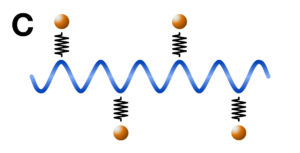Area C: Quantum cooperativity induced by interactions
Summary of the area
Research Area C embraces projects where the interactions between the individual constituents are engineered. This includes the exchange of photons and a direct matter-matter coupling by quasi static electric and/or magnetic interactions. The cooperative response is then observed in the spatiotemporal structure of the emitted electromagnetic radiation. The corresponding signatures of cooperative behavior are the observation of super- and subradiant emission, the onset of spatio-temporal photon correlations including the emission of non-classical light. Research Area C investigates furthermore the impact of different dimensionalities, geometries, in the presence of disorder, and of the boundary conditions on the cooperative behavior of its platforms. In particular, structuring of media, control of thermal fluctuations and control of the coupling to the environment allows for a detailed analysis of the impact of noise, fluctuations, and dissipation on the cooperative response of the systems.
Projects
- C01 – One-dimensional photon-mediated cooperativity of quantum emitters
- C02 – Light-induced correlations in dense atomic media
- C03 – Mechanical and chemical control of single and multiphoton emission
- C04 – X-ray Photonic Structures for Control of Cooperative Emission from Resonant Nuclei
- C05 – Quantum cooperative helical metafilms for producing nonclassical light
Publications
2023
- , , , , , , :
Collectively Enhanced Giant Circular Dichroism of Germanium Nanohelix Square Lattice Arrays
In: Advanced Photonics Research 4 (2023)
ISSN: 2699-9293
DOI: 10.1002/adpr.202300159 - , , , , , , :
Quantum Efficiency of Single Dibenzoterrylene Molecules in p-Dichlorobenzene at Cryogenic Temperatures
In: Journal of Physical Chemistry B 127 (2023), p. 5353-5359
ISSN: 1520-6106
DOI: 10.1021/acs.jpcb.3c01755 - , , , , , , , , :
Photon pairs bi-directionally emitted from a resonant metasurface
In: Nanoscale (2023)
ISSN: 2040-3364
DOI: 10.1039/d2nr05499j
2022
- , , , , , , , , :
Excitation localization in a trimeric perylenediimide macrocycle: Synthesis, theory, and single molecule spectroscopy
In: Journal of Chemical Physics 156 (2022), Article No.: 044304
ISSN: 0021-9606
DOI: 10.1063/5.0077676 - , , , , , , :
Resonant metasurfaces for generating complex quantum states
In: Science 377 (2022), p. 991-995
ISSN: 0036-8075
DOI: 10.1126/science.abq8684 - , , :
Flat-optics generation of broadband photon pairs with tunable polarization entanglement
In: Optics Letters 47 (2022), p. 3872-3875
ISSN: 0146-9592
DOI: 10.1364/OL.458133
2021
- , :
Superradiance and anomalous hyperfine splitting in inhomogeneous ensembles
In: Physical Review A 104 (2021)
ISSN: 1050-2947
DOI: 10.1103/PhysRevA.104.033702 - , , , , :
Embedding photoacids into polymer opal structures: Synergistic effects on optical and stimuli-responsive features
In: Molecules 26 (2021), Article No.: 7350
ISSN: 1420-3049
DOI: 10.3390/molecules26237350 - , , , , , , , , :
Detection of the Faraday Chiral Anisotropy
In: Physical Review Letters 126 (2021), Article No.: 177401
ISSN: 0031-9007
DOI: 10.1103/PhysRevLett.126.177401 - , , , , , , , :
Dose-dependent milling efficiencies of helium and nitrogen beams in PMMA
In: Microelectronic Engineering 249 (2021), Article No.: 111621
ISSN: 0167-9317
DOI: 10.1016/j.mee.2021.111621 - , , , , , , , , , :
Photon Pairs from Resonant Metasurfaces
In: Nano Letters (2021)
ISSN: 1530-6984
DOI: 10.1021/acs.nanolett.1c01125

